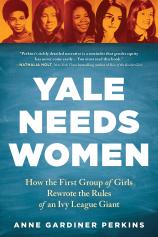Yale Needs Women: How the First Group of Girls Rewrote the Rules of an Ivy League Giant
Review
Yale Needs Women: How the First Group of Girls Rewrote the Rules of an Ivy League Giant
YALE NEEDS WOMEN provides an in-depth, fascinating look at the process by which Yale University became a coeducational institution in 1969 and the subsequent struggle to make coeducation succeed. Anne Gardiner Perkins skillfully places the subject matter into the larger context of the tumultuous years during which it unfolded, examining the backdrop of the fundamental cultural shifts that occurred in the United States in the late 1960s and early 1970s.
Yale’s decision to admit women was neither well-thought out nor well-developed before it was implemented, which created problems that would not be resolved for years to come. Its revered president, Kingman Brewster Jr., was open-minded and fairly progressive on some issues, such as admitting students from a wide variety of backgrounds and races and voicing opposition to the Vietnam War, but his opinions on allowing women to attend Yale were outdated and sexist. He believed that “admitting women students threatened the central mission of Yale: graduating America’s future leaders.”
"[Perkins'] attention to detail and her logical chronology combine to create an intriguing and at times depressing look at an elite institution that would need to be unwillingly dragged into the modern era."
Beginning in 1966, Lanny Davis, chairman of the influential student-run Yale Daily News, had been advocating for the admission of women, stating in his debut editorial, “Coeducation should now be beyond argument.” Brewster ignored the issue until 1968 when his hand was forced. Pressed by current students on one side and the admissions office and certain trustees on the other, he finally understood that admitting women to Yale was a necessity.
Weary of Brewster’s refusal to listen to their pleas, Yale students staged a highly public protest called Coeducation Week, which brought 750 women to Yale in the fall of 1968. It was covered by the national media, and Yale was thrust directly into the spotlight on this issue. Moreover, it wasn’t just students who were advocating for coeducation. The support from the faculty for allowing undergraduate females (the law school and other graduate schools already admitted women) to attend Yale was high. When Brewster finally presented his coeducation proposal to the Yale College faculty, the group approved it 200:1.
While the students were growing louder and more frustrated over Brewster’s refusal to admit women, the issue that actually swayed him was related to admissions. In 1968, more than 40 percent of those admitted to Yale were attending other schools, and over 75 percent of those accepted to Harvard and Yale chose Harvard. Both groups cited Yale’s refusal to admit women as their primary reason for rejecting it. While other schools had female colleges nearby, Yale did not, and its lack of women was severely impacting its standing.
Pressured into a decision he did not want to make, Brewster agreed to admit women, but only if there was little or no disruption to Yale’s education standards. Once he chose to move forward with coeducation, Brewster hastily implemented this important change in only 10 months instead of creating a logical and well-detailed plan for integrating women into the culture at Yale. His narrow-mindedness on this issue resulted in a variety of problems that would require years to rectify in order to make coeducation successful at Yale.
A Yale graduate herself, Perkins crafts a thoroughly researched and comprehensive look at the university's coeducation process. She incorporates the events taking place in the United States as a whole during this time period and demonstrates how some of these occurrences helped shape coeducation decisions at Yale. In addition, she interviewed countless women and men and scoured through hundreds of documents in order to write YALE NEEDS WOMEN. Her attention to detail and her logical chronology combine to create an intriguing and at times depressing look at an elite institution that would need to be unwillingly dragged into the modern era.
Reviewed by Cindy Burnett on September 13, 2019
Yale Needs Women: How the First Group of Girls Rewrote the Rules of an Ivy League Giant
- Publication Date: July 6, 2021
- Genres: Biography, History, Nonfiction, Women's Studies
- Paperback: 400 pages
- Publisher: Sourcebooks
- ISBN-10: 1728234611
- ISBN-13: 9781728234618




